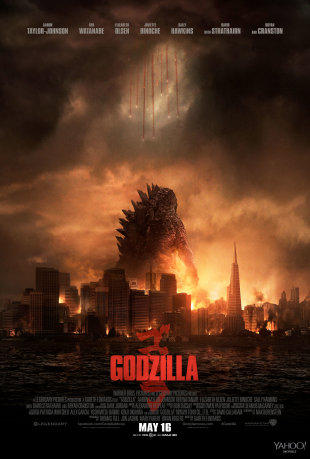Ever since the Japanese original "Godzilla" (first titled "Godjira") took the horror genre to all new heights, literally and figuratively, with its larger-than-life reptilian beast, there've been a number of very varied attempts to capitalize on the creature's fear potential. The latest of which — director Gareth Edwards's upcoming release starring Aaron Taylor-Johnson, Elizabeth Olsen, and Bryan Cranston — just released a new trailer that is bigger in scale than any previous incarnation, smashing up everything from San Francisco to Las Vegas
While some installments have been more favored than others, from the looks (and sounds) of this newest iteration it seems that Edwards's take might just be hearkening back more to the roots of Godzilla's movie magic — especially within the latest round of materials released from the pic.
But does this new remake of the monster pass muster with fans of the classic version? VIDEO
Empire Online's "Godzilla"-centric cover features a full-length black-and-white image of the new take on the havoc-wreaker, striking a familiar pose as he looms over a hopeless city-scape.
It resembles certain iconic moments from the original film, and according to Steve Ryfle — a film historian and author of the first English-language book on the "Godzilla" films, "Japan's Favorite Mon-Star: The Unauthorized Biography of 'The Big G'" — it does play better with the character's deep fan base.
"It looks like a reinterpretation," he told Yahoo Movies, "but I think it's much closer to the Japanese source material, the Japanese 'Godzilla' design, than the '98 film by Roland Emmerich."
The first "Godzilla," he explained, "started off as something that had been clearly altered or mutated by an atomic explosion. It had a very scarified hide, and it's skin had very much more evidence of radiation." And whereas over time the look of Godzilla has changed significantly — even becoming "Muppet-like" at one point to appeal to younger audiences — Mr. Ryfle sees this picture as being a lot more like the O.G. (that's Original Godzilla).
"It's clear that these filmmakers are trying to pay homage to the original one in certain respects," he said — in particular, by letting him "look more like a monster" than some of the other variations.
In addition, Warner Bros. has also unleashed a new soundbite focusing on the creature's ominous roar in its remake — a seemingly deeper version than what was heard in the film's trailer from December.
According to Ryfle, there's a good reason the studio's putting such emphasis on the creature's scream.
 'Godzilla' (Warner Bros. Pictures)"It's kind of intrinsically tied with the character's identity," he said, and "a lot of people can imitate Godzilla's roar, even if they wouldn't call themselves fans of the character."
'Godzilla' (Warner Bros. Pictures)"It's kind of intrinsically tied with the character's identity," he said, and "a lot of people can imitate Godzilla's roar, even if they wouldn't call themselves fans of the character."
As for the results? "It sounds very much like what we know Godzilla sounds like" — even if the seconds building up to it do come off "a little like a jet taking off."
Two for two then, so far. But still, the convincing is far from complete.
One thing the filmmaking team on this reboot still has to yet to prove to the series' core audience — and which Ryfle thinks is going to ultimately make or break this interpretation — is how it handles Godzilla's behavioral aspects.
"I think one of the reasons that fans of these types of films rejected the one that was made in 1998 is not just because of the way the creature looked, but it was probably more because of the way it behaved," Ryfle said. "It didn't behave in a way that you associate with this character." But if the new version looks like the original and sounds like the original, maybe it will stomp like the original, too.
"Godzilla" hits theaters on May 16.
Compare the new 'Godzilla' with the trailer for the re-release of the original:


